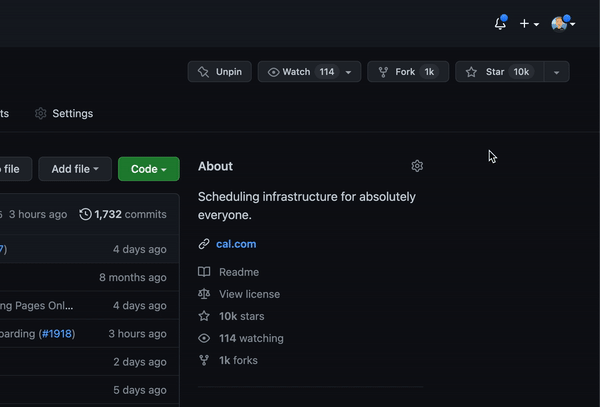Categories
Tags
Agents AI ai AI Search Analysis animation Astro AudioGPT Awesome Bruno Cal.com Chatbot chatbot Cline Code CrewAI Dicebear edit editor enhance Frappe GitHub image Jan Jinni KaibanJS KoboldAI LangChain LibreChat LlamaIndex Lobe LocalAI Million Motion Npcpy Ollama open-source PaLM Perplexica Postiz Private Prompt Qrev RAG Ragflow real-time resolution Screenshot Second Stable Strapi TerminalGPT Text Typescript Workflowai
Cal.com
Description not set
Title: Diving into Cal.com: A Comprehensive Analysis of the Scheduling Revolution Platform
Introduction: Cal.com is a revolutionary scheduling platform that simplifies meeting coordination, making it a breeze for individuals and businesses alike to organize appointments, events, and collaborations seamlessly. This open-source project on GitHub serves as the backbone of Cal.com’s powerful features, bridging the gap between busy schedules and effective communication.
Key Technical Details:
Main Features & Capabilities:
- Link scheduling: Generate customizable links to schedule meetings with multiple attendees across different time zones.
- Availability sync: Integrate calendars from various services like Google Calendar, Outlook, and Apple Calendar for seamless availability checks.
- Event notifications: Stay informed with email reminders before events, reducing the chances of double bookings and forgotten meetings.
- Customizable scheduling pages: Create professional-looking webpages that match your brand to schedule appointments directly.
Technical Stack & Architecture:
- Backend: Node.js (Express) with MongoDB for data storage.
- Frontend: React for building user interfaces, and Redux for managing state.
- API: A RESTful API for communication between frontend, backend, and third-party services like Google Calendar API.
Notable Components or Patterns:
- Microservices architecture: The application is split into smaller, manageable components, each with a specific function, promoting scalability and maintainability.
- OAuth2 authentication: Ensuring secure access to user data through third-party providers like Google and Microsoft.
- Responsive design: Adapting the web interface to different screen sizes and devices for optimal user experience.
Learning Points or Interesting Aspects:
- Real-time updates with Socket.IO: Implement a real-time communication library that facilitates immediate responses in various scenarios, such as updating availability statuses.
- Localization: Leverage i18n to make the application accessible to users worldwide by supporting multiple languages.
- Test-driven development: Adopt a testing strategy based on unit tests, integration tests, and end-to-end tests using Jest and Cypress to ensure code quality and maintainability.
